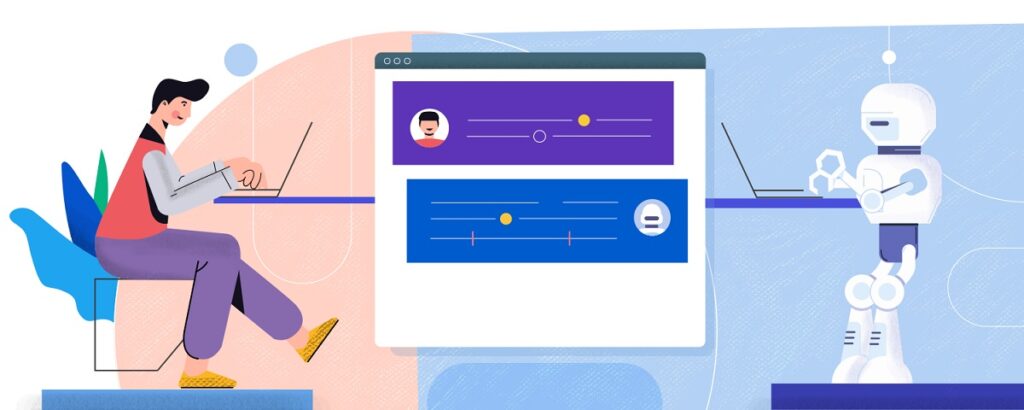Will AI Chatbots Replace Human Customer Service?
The latest sci-fi would have you believe that machine vs. human is the ultimate war. In fact, many lament the ways in which AI lacks a deeper understanding of language, and yet, many can also see limitations in human interactions. Both man and the mechanical beast that serves it are imperfect, it seems.
The Need for Human Connection
Traditional customer service, such as call centers, have 29.4% of the world’s global market. In-house employees handle complaints by phone and email, using communication scripts when talking to customers. They are trained in effective communication, usually with strong verbal and written communication skills.
Human communication is one of the best ways to resolve problems, particularly complex problems, between customers and businesses. For problems that require critical thinking and analysis, human interaction provides. A study by Forbes Magazine shows that 86% of customers still prefer speaking to humans than to chatbots.
The Human Vulnerabilities
Yet, as much as customers crave human connection, this connection can show human vulnerabilities as well:
- a whole customer service team is more costly than one chatbot.
- a customer wants to solve a problem within minutes, which simply just cannot be done by a customer service agent all the time.
- complex problems require time and effort that might be solved faster by a more evolved AI.
- there are long wait-times, unavailability in email, and other inefficient communication that could cost companies customers.
A study by Hubspot shows that 42% of customers use live chat, 62% use email, 36% use “Contact Us” forms to communicate with customer service. This means that digital communication is still a preferred form of communication, regardless of whether human or machine is behind it. This knowledge could be used by companies to leverage their chatbots alongside their human customer service.
The Conversational Chatbot As A Solution
Today, AI chatbot software has the ability to simulate human conversations. As a result, they can help customer service teams improve their performance manifold by serving more customers, proactively engaging them at all times, and providing accurate information and speedy resolutions. It uses natural language processing (NLP) which helps to understand the human conversation, which includes summarization, translation, and answering questions. It also uses machine learning, which helps automatically learn and improve over time from its experiences. Furthermore, it uses AI deep learning which uses artificial neural networks to analyze data.
A conversational AI chatbot can do much more than a customer service team. A conversations AI chatbot can simulate human conversations. Virtual assistants are now composed mainly of conversational AI. Amazon’s Alexa, Apple’s Siri, and Google Home are examples of this. Virtual “Customer” Assistants are more specialized and more advanced. They offer precise answers and intuitive responses, simulating human conversations and taking action for the customer.
How to Leverage Customer Service With Both Human and Machine
While AI can replace certain functions or roles of humans, such as customer service representatives, it won’t be for a time, if ever, that they will replace human customer service. What machines can do is help in a user’s customer service journey.
Companies Who Do This Well
Hand-in-hand with human customer service agents as the middlemen machines at the beginning of the user journey. Here are some examples of modern chatbots integrated with human agents:
- Bank of America, for example, has a virtual assistant named Erica. This chatbot helps mobile app users with basic banking needs. If the query escalates to need a human agent, Erica connects users with call center agents. It’s there at the very beginning of the journey.
- Nuance is another example of AI done right, with their acquisition of Saykara. Pronounced “say-care-a” this mobile AI is a virtual assistant for the medical field. Saykara automates the technical processes between patient and doctor, setting up medical appointments to obtaining patient consents and more. It acts as a middleman between the medical staff and patients.
- Netomi is a Silicon Valley company and they have a customer service chatbot of the same name. It’s available 24/7, 7 days a week, basically whenever you have a problem. This accomplishes tasks so that the human agent is freer to do other things. If the AI can’t handle the issue, it’s smart enough to hand the issue over to a human agent. Like Erica, it’s there at the beginning of the journey.
So the #1 advice is: human-AI integration. Use AI at the beginning of the customer service journey, but don’t rely on it alone.
Translation Services Integrating Human To AI
At the heart of the customer service journey is language. If you don’t know how to communicate to the customer in their preferred language, then you won’t be able to serve the customer in meaningful ways. This is why you can hear a lot of automated phone calling systems saying “Press 1 for English, Press 2 for Spanish” and so on.
The need to relate to consumers in their own language is key. Whether your customer service team has an in-house translation team or you’re outsourcing to translation services with a network of professionals, AI and human translation will work together to benefit customer service relationships with customers.
As technology is advancing, machine translation as much of a necessity as an AI chatbot. But, they won’t ever replace human translators and human customer service agents. We will not be defeated by the things we make.


























